Reducing the Sodium Adsorption Ratio Improves the Soil Aggregates and Organic Matter in Brackish-Water-Irrigated Cotton Fields
Abstract
:1. Introduction
2. Materials and Methods
2.1. Overview of Experimental Area
2.2. Experimental Design
2.3. Sampling and Field Measurements
2.3.1. Determination of Soil Ions and Sodium Adsorption Ratio (SAR)
2.3.2. Soil Aggregates
2.4. Data Processing and Analysis
3. Results
3.1. Impact of Saline Water Irrigation on Soil Ion Content and Soil SAR
3.1.1. Impact of Saline Water Irrigation on Soil Na+, Ca2+, and Mg2+ Content
3.1.2. Impact of Saline Irrigation on Soil SAR
3.2. Impact of Saline Water Irrigation on Soil Aggregates
3.2.1. Impact of Saline Water Irrigation on Soil Macroaggregate Stability
3.2.2. The Impact of Saline Water Irrigation on Soil Water-Stable Aggregates
3.3. The Impact of Saline Water Irrigation on Soil Organic Matter
3.4. The Correlation Analysis of Indicators
4. Discussion
4.1. The Effect of Different Ion Composition in Saline Water on Partial Soil Ions and Sodium Adsorption Ratio (SAR)
4.2. The Impact of Different Ion Compositions in Saline Water on Soil Aggregates
4.3. The Impact of Different Ion Compositions in Saline Water on Soil Organic Matter
5. Conclusions
Author Contributions
Funding
Data Availability Statement
Conflicts of Interest
References
- Rizwan, M.; Zaheer, J.; Tahir, M.; Ansar, M.; Ali, M. Benefits of Research and Development on Cotton Crop: Lessons from China. Dinkum J. Nat. Sci. Innov. 2023, 2, 509–513. [Google Scholar]
- National Bureau of Statistics. Announcement on 2023 Cotton Production. China Information News, 26 December 2023. [Google Scholar] [CrossRef]
- Wang, H.; Feng, D.; Zhang, A.; Zheng, C.; Li, K.; Ning, S.; Zhang, J.; Sun, C. Effects of saline water mulched drip irrigation on cotton yield and soil quality in the North China Plain. Agric. Water Manag. 2022, 262, 107405. [Google Scholar] [CrossRef]
- Zhang, J.P.; Feng, D.; Cao, C.Y.; Sun, J.S.; Sun, C.T.; Zheng, C.L.; Liu, H. Effects of irrigation with saline water on growth and water use efficiency of film-mulched cotton plant. J. Drain. Irrig. Mach. Eng. 2014, 32, 448–455. [Google Scholar]
- Yang, G.; Li, F.; Tian, L.; He, X.; Gao, Y.; Wang, Z.; Ren, F. Soil physicochemical properties and cotton (Gossypium hirsutum L.) yield under brackish water mulched drip irrigation. Soil Tillage Res. 2020, 199, 104592. [Google Scholar] [CrossRef]
- Li, W.; Zhao, L.; Yang, G.; Yan, K.; He, X.; Gao, Y.; Xue, L.; Li, F.; Wu, Y. Water source and transmission in Haloxylon ammodendron in the desert margin of the Manas River Basin, China. Isr. J. Ecol. Evol. 2021, 67, 156–167. [Google Scholar] [CrossRef]
- Rodrigues, V.d.S.; Sousa, G.d.; Saraiva, S.E.L.; Cardoso, E.d.C.; Pereira Filho, J.V.; Viana, T.d.A. Atributos químicos do solo em área cultivada com milho sob irrigação com água salina. Rev. Bras. Agric. Irrig. 2018, 12, 3129–3138. [Google Scholar] [CrossRef]
- Wu, Y.; Zheng, C.; Li, K.; Dang, H.; Li, Q.; Li, S.; Zhang, J. Effect of Saline Water Irrigation on Soil Water-stable Aggregates in Wheat-maize Crop Double Cropping System. J. Soil Water Conserv. 2021, 35, 288–294+308. [Google Scholar]
- Zhu, C.; Yang, H.; Feng, G.; Han, L.; Wang, C.; Zhai, Y.; Feng, B.; Zhao, T. Effect of vertically rotary sub-soiling tillage and saline water irrigation on water and salt movement in soil. J. Irrig. Draijnage 2024, 43, 1–7. [Google Scholar] [CrossRef]
- Guo, X.; Yang, M.; Ye, Y.; Guo, H.; Min, W. Response of ammonia-oxidzing microbial community to irrigation water salinity and nitrogen application in grey desert soil of cotton field in Xinjiang. Agric. Res. Arid. Areas 2024, 42, 231–244. [Google Scholar] [CrossRef]
- Rajkumar, R.; Nemichandrappa, M.; Anilkumar, T.D.; Ayyanagowdar, M.; Polisgowdar, B.; Satyanarayana, R.; Vishwanatha, J. Effect of different irrigation methods and saline water on soil properties in tomato (Solanum lycopersicum) crop under vertisols of Tungabhadra project command. Int. J. Chem. Stud. 2019, 7, 2952–2957. [Google Scholar]
- Qiao, R.; Cheng, Y.; Yan, S.; Luo, M.; Wang, C.; Zhang, T.; Zhang, T. Effects of saline water with different cations on soil hydraulic properties and lettuce growth. J. Drain. Irrig. Mach. Eng. 2023, 41, 288–295. [Google Scholar] [CrossRef]
- Zhou, Y.; Chen, J.; Li, Y.; Hou, Z.; Min, W. Effects of Cotton Stalk Returning on Soil Enzyme Activity and Bacterial Community Structure Diversity in Cotton Field with Long-term Saline Water Ittigation. Environ. Sci. 2022, 43, 2192–2203. [Google Scholar] [CrossRef]
- Li, B.; Cao, Y.; Guan, X.; Li, Y.; Hao, Z.; Hu, W.; Chen, L. Microbial assessments of soil with a 40-year history of reclaimed wastewater irrigation. Sci. Total Environ. 2019, 651, 696–705. [Google Scholar] [CrossRef] [PubMed]
- Zhou, S.; Wang, G.; Zhang, J.; Dang, H.; Gao, Y.; Sun, J. Long-term saline water irrigation has the potential to balance greenhouse gas emissions and cotton yield in North China plain. J. Environ. Manag. 2024, 352, 120087. [Google Scholar] [CrossRef] [PubMed]
- Ahmad, S.; Hussain, I.; Ghaffar, A.; Rahman, M.H.U.; Saleem, M.Z.; Yonas, M.W.; Hussnain, H.; Ikram, R.M.; Arslan, M. Organic amendments and conservation tillage improve cotton productivity and soil health indices under arid climate. Sci. Rep. 2022, 12, 14072. [Google Scholar] [CrossRef] [PubMed]
- Tao, R.; Hu, B.; Chu, G. Impacts of organic fertilization with a drip irrigation system on bacterial and fungal communities in cotton field. Agric. Syst. 2020, 182, 102820. [Google Scholar] [CrossRef]
- Soares, L.A.d.A.; Fernandes, P.D.; Lima, G.S.d.; Silva, S.S.d.; Moreira, R.C.; Medeiros, T.L. Phytomass and production components of colored cotton under salt stress in different phenological stages. Rev. Bras. Eng. Agrícola E Ambient. 2021, 25, 132–138. [Google Scholar] [CrossRef]
- Chen, W.; Jin, M.; Ferre, T.P.A.; Liu, Y.; Xian, Y.; Shan, T.; Ping, X. Corrigendum to ‘Spatial distribution of soil moisture, soil salinity, and root density beneath a cotton field under mulched drip irrigation with brackish and fresh water’ [Field Crops Research 215 (2018) 207–221]. Field Crops Res. 2018, 226, 83. [Google Scholar] [CrossRef]
- Xiao, C.; Li, M.; Fan, J.; Zhang, F.; Li, Y.; Cheng, H.; Li, Y.; Hou, X.; Chen, J. Salt Leaching with Brackish Water during Growing Season Improves Cotton Growth and Productivity, Water Use Efficiency and Soil Sustainability in Southern Xinjiang. Water 2021, 13, 2602. [Google Scholar] [CrossRef]
- Saadat, S.; Esmaeelnejad, L.; Rezaei, H.; Mirkhani, R.; Seyedmohammadi, J. Comparing aggregate stability tests as one of the soil physical quality indicators. J. Water Soil 2019, 33, Pe289–Pe303. [Google Scholar]
- Wang, L.; Liu, H.; Gao, F.; Ning, H.; Han, Q.; Xu, X.; Wang, X.; Li, X. Effects of Different Planting Patterns and Irrigation Quota on Cotton Growth ang Yield. J. Irrig. Drain. 2023, 42, 16–23. [Google Scholar] [CrossRef]
- Wang, L. Effects of Irrigation Quota on Machine Harvested Cotton RootShoot Growth and Yield under Different Planting Patterns in Southern Xinjiang. Ph.D. Thesis, Tarim University, Xinjiang, China, 2023. [Google Scholar] [CrossRef]
- Gao, F. Effects of Drip Spring Irrigation on Water-Heat-Salt Distribution and Cotton Growth in Mulched Cotton Fields in Southern Xinjiang. Master’s Thesis, Chinese Academy of Agricultural Sciences, Beijing, China, 2023. [Google Scholar] [CrossRef]
- LY/T 1251-1999; Analysis Methods of Water Soluble Salts of Forest Soil. Department of Soil and Plant Nutrition, Beijing Agricultural University: Beijing, China, 1999.
- Shams, M.S.; Aboushal, A.A.; Saffan, M.M.; El-Kammah, M.A.; Rateb, K.; El-Ramady, H.R. Validity of light transmittance to predict soil hydraulic conductivity in salt-affected soils. Egypt. J. Soil Sci. 2016, 56, 723–738. [Google Scholar]
- Liu, Q.; Pang, X.-Y.; Xiang, S.; Pan, K.-W. Restoration of degraded alpine and subalpine forest ecosystems in different stages of succession in southwestern China. Chin. J. Appl. Environ. Biol. 2021, 27, 513–518. [Google Scholar] [CrossRef]
- Saeed, Q.; Zhang, A.; Mustafa, A.; Sun, B.; Zhang, S.; Yang, X. Effect of long-term fertilization on greenhouse gas emissions and carbon footprints in northwest China: A field scale investigation using wheat-maize-fallow rotation cycles. J. Clean. Prod. 2022, 332, 130075. [Google Scholar] [CrossRef]
- Abubakar, S.A.; Hamani, A.K.M.; Chen, J.; Sun, W.; Wang, G.; Gao, Y.; Duan, A. Optimizing N-fertigation scheduling maintains yield and mitigates global warming potential of winter wheat field in North China Plain. J. Clean. Prod. 2022, 357, 131906. [Google Scholar] [CrossRef]
- Negis, H. Impacts of Maize and Sunflower Straw Implementations on Selected Physical and Mechanical Properties of Clay Soil. Commun. Soil Sci. Plant Anal. 2024, 55, 441–455. [Google Scholar] [CrossRef]
- Pallant, J. SPSS Survival Manual: A Step by Step Guide to Data Analysis Using IBM SPSS; Routledge: London, UK, 2020. [Google Scholar]
- Xiao, S.; Zhang, W.; Ye, Y.; Zhao, J.; Wang, K. Soil aggregate mediates the impacts of land uses on organic carbon, total nitrogen, and microbial activity in a Karst ecosystem. Sci. Rep. 2017, 7, 41402. [Google Scholar] [CrossRef]
- Ju, Z.; Du, Z.; Guo, K.; Liu, X. Irrigation with freezing saline water for 6years alters salt ion distribution within soil aggregates. J. Soils Sediments 2019, 19, 97–105. [Google Scholar] [CrossRef]
- Liu, X.; Yan, F.; Wu, L.; Zhang, F.; Yin, F.; Abdelghany, A.E.; Fan, J.; Xiao, C.; Li, J.; Li, Z. Leaching amount and timing modified the ionic composition of saline-alkaline soil and increased seed cotton yield under mulched drip irrigation. Field Crops Res. 2023, 299, 108988. [Google Scholar] [CrossRef]
- Shehzad, I.; Sarwar, G.; Manzoor, M.Z.; Zafar, A.; Muhammad, S.; Murtaza, G. Effect of saline water irrigation on chemical properties and fertility status of soil. Pak. J. Agric. Res. 2020, 33, 527–534. [Google Scholar] [CrossRef]
- Dastranj, M.; Sepaskhah, A.R. Effect of Irrigation Water Salinity and Deficit Irrigation on Soil Ions Variation and Uptake by Saffron (Crocus sativus L.) Under Two Planting Methods. J. Plant Growth Regul. 2022, 41, 282–299. [Google Scholar] [CrossRef]
- Huang, C.H.; Xue, X.; Wang, T.; De Mascellis, R.; Mele, G.; You, Q.G.; Peng, F.; Tedeschi, A. Effects of saline water irrigation on soil properties in northwest China. Environ. Earth Sci. 2011, 63, 701–708. [Google Scholar] [CrossRef]
- Li, J. Increasing crop productivity in an eco-friendly manner by improving sprinkler and micro-irrigation design and management: A review of 20 years’ research at the iwhr, China. Irrig. Drain. 2018, 67, 97–112. [Google Scholar] [CrossRef]
- Lu, X.; Hou, E.; Guo, J.; Gilliam, F.S.; Li, J.; Tang, S.; Kuang, Y. Nitrogen addition stimulates soil aggregation and enhances carbon storage in terrestrial ecosystems of China: A meta-analysis. Glob. Change Biol. 2021, 27, 2780–2792. [Google Scholar] [CrossRef]
- Dai, W.; Feng, G.; Huang, Y.; Adeli, A.; Jenkins, J.N. Influence of cover crops on soil aggregate stability, size distribution and related factors in a no-till field. Soil Tillage Res. 2024, 244, 106197. [Google Scholar] [CrossRef]
- Kantrikrom, R.; Anusontpornperm, S.; Thanachit, S.; Wiriyakitnateekul, W. Water stable aggregate distribution of lowland, humid, tropical, salt-affected soils. Agric. Nat. Resour. 2020, 54, 255–264. [Google Scholar] [CrossRef]
- Ding, W.-F.; Zhang, X.-C. An evaluation on using soil aggregate stability as the indicator of interrill erodibility. J. Mt. Sci. 2016, 13, 831–843. [Google Scholar] [CrossRef]
- Bi, Y.-P.; Zheng, C.-L.; Dang, H.-K.; Cao, C.-Y.; Li, K.-J.; Ma, J.-Y.; Wang, H.; Zhang, J.-P. Effects of saline-water furrow irrigation on the stability of soil water-stable aggregates in cotton field. Ying Yong Sheng Tai Xue Bao J. Appl. Ecol. 2022, 33, 1055–1062. [Google Scholar] [CrossRef]
- Li, S.; Wang, B.; Zhang, X.; Wang, H.; Yi, Y.; Huang, X.; Gao, X.; Zhu, P.; Han, W. Soil particle aggregation and aggregate stability associated with ion specificity and organic matter content. Geoderma 2023, 429, 116285. [Google Scholar] [CrossRef]
- Bray, N.; Thompson, G.L.; Fahey, T.; Kao-Kniffin, J.; Wickings, K. Soil macroinvertebrates alter the fate of root and rhizosphere carbon and nitrogen in a turfgrass lawn. Soil Biol. Biochem. 2020, 148, 107903. [Google Scholar] [CrossRef]
- Setia, R.; Rengasamy, P.; Marschner, P. Effect of exchangeable cation concentration on sorption and desorption of dissolved organic carbon in saline soils. Sci. Total Environ. 2013, 465, 226–232. [Google Scholar] [CrossRef] [PubMed]
- Paul, E.A. The nature and dynamics of soil organic matter: Plant inputs, microbial transformations, and organic matter stabilization. Soil Biol. Biochem. 2016, 98, 109–126. [Google Scholar] [CrossRef]
- Wei, K.; Zhang, J.; Wang, Q.; Guo, Y.; Mu, W. Irrigation with ionized brackish water affects cotton yield and water use efficiency. Ind. Crops Prod. 2022, 175, 114244. [Google Scholar] [CrossRef]
- Zhang, Y.; Miao, S.H.; Song, Y.; Wang, X.D.; Jin, F. Biochar Application Reduces Saline-Alkali Stress by Improving Soil Functions and Regulating the Diversity and Abundance of Soil Bacterial Community in Highly Saline-Alkali Paddy Field. Sustainability 2024, 16, 1001. [Google Scholar] [CrossRef]
- Liang, C.; Amelung, W.; Lehmann, J.; Kaestner, M. Quantitative assessment of microbial necromass contribution to soil organic matter. Glob. Change Biol. 2019, 25, 3578–3590. [Google Scholar] [CrossRef]
- Liu, C.; Shang, H.Z.; Han, L.H.; Sun, X.R. Effect of alkali residue and humic acid on aggregate structure of saline-alkali soil. Soil Sci. Soc. Am. J. 2024, 88, 291–303. [Google Scholar] [CrossRef]
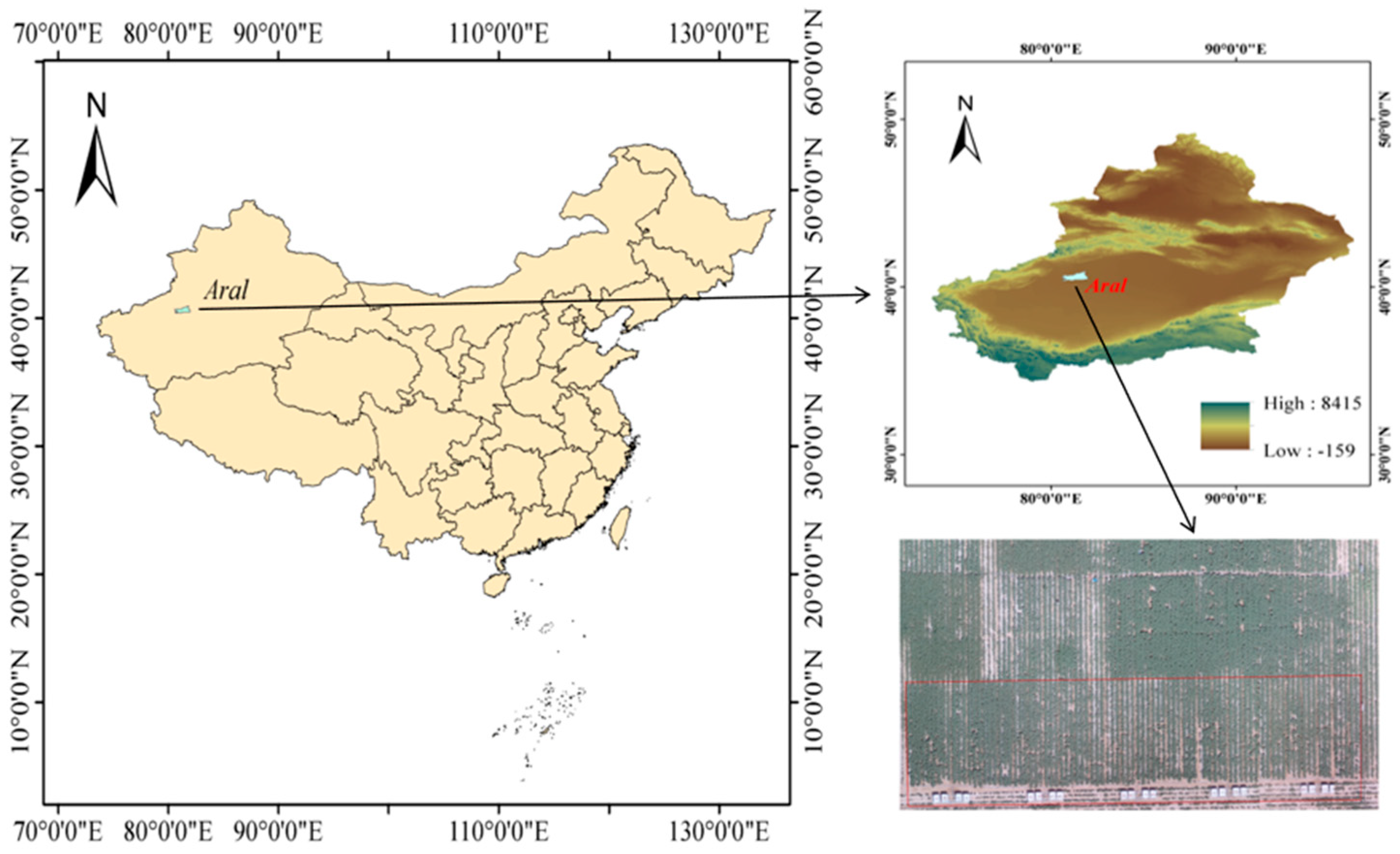
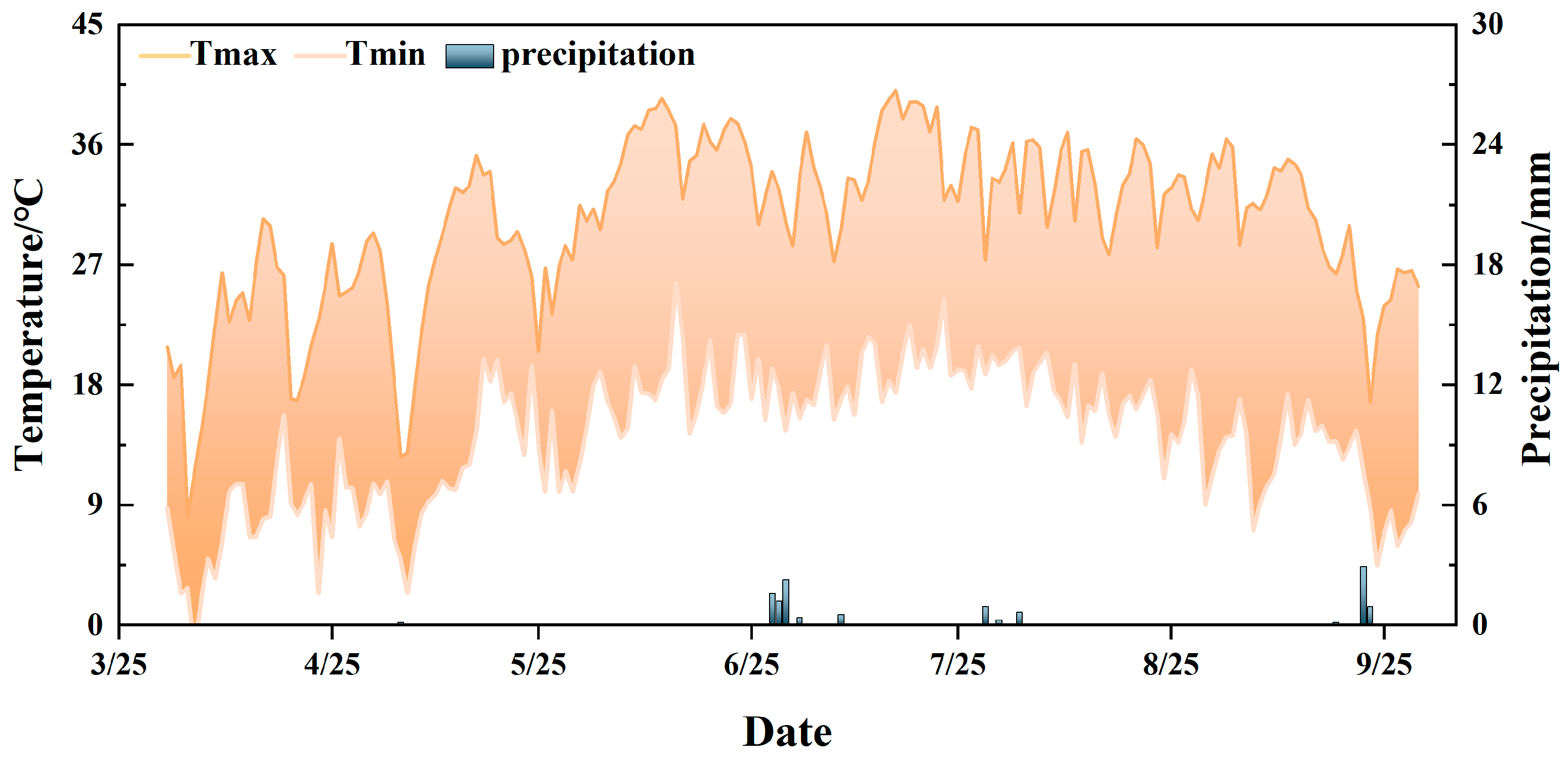
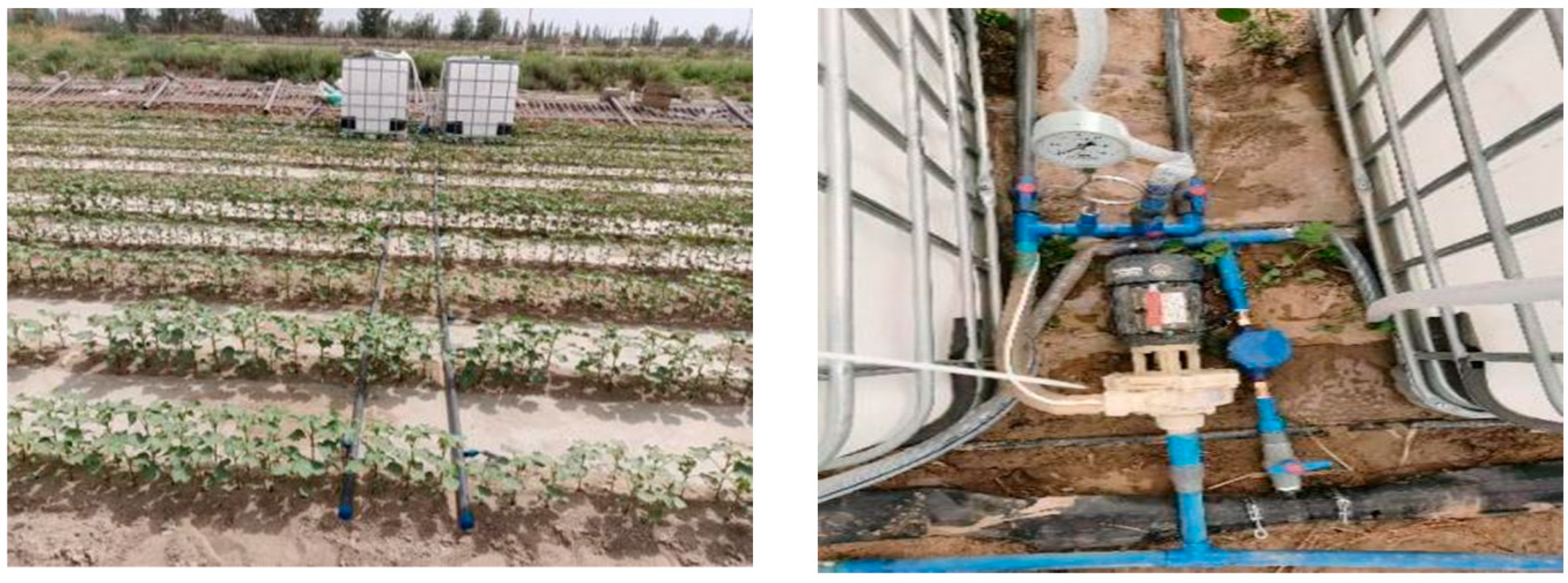
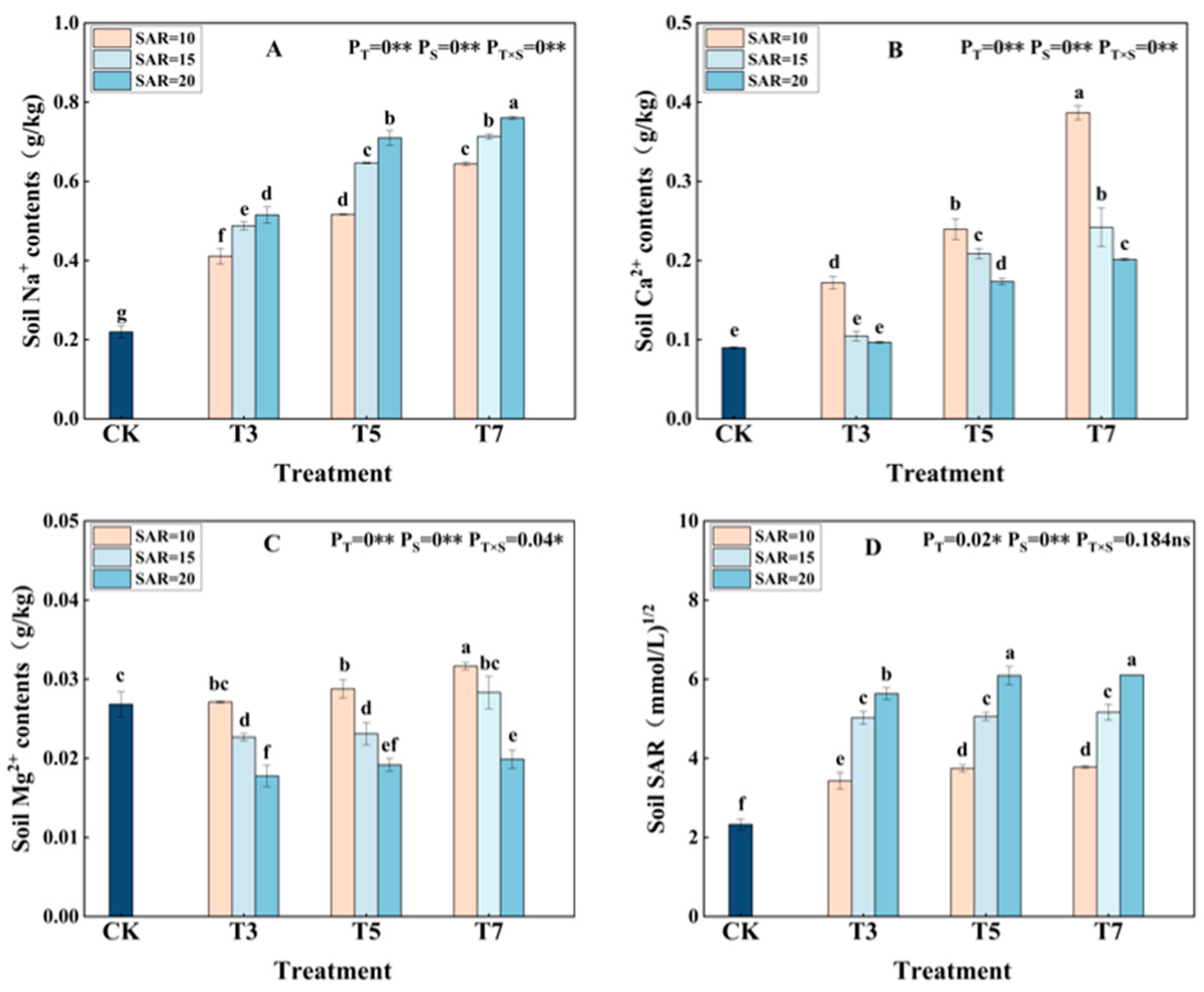

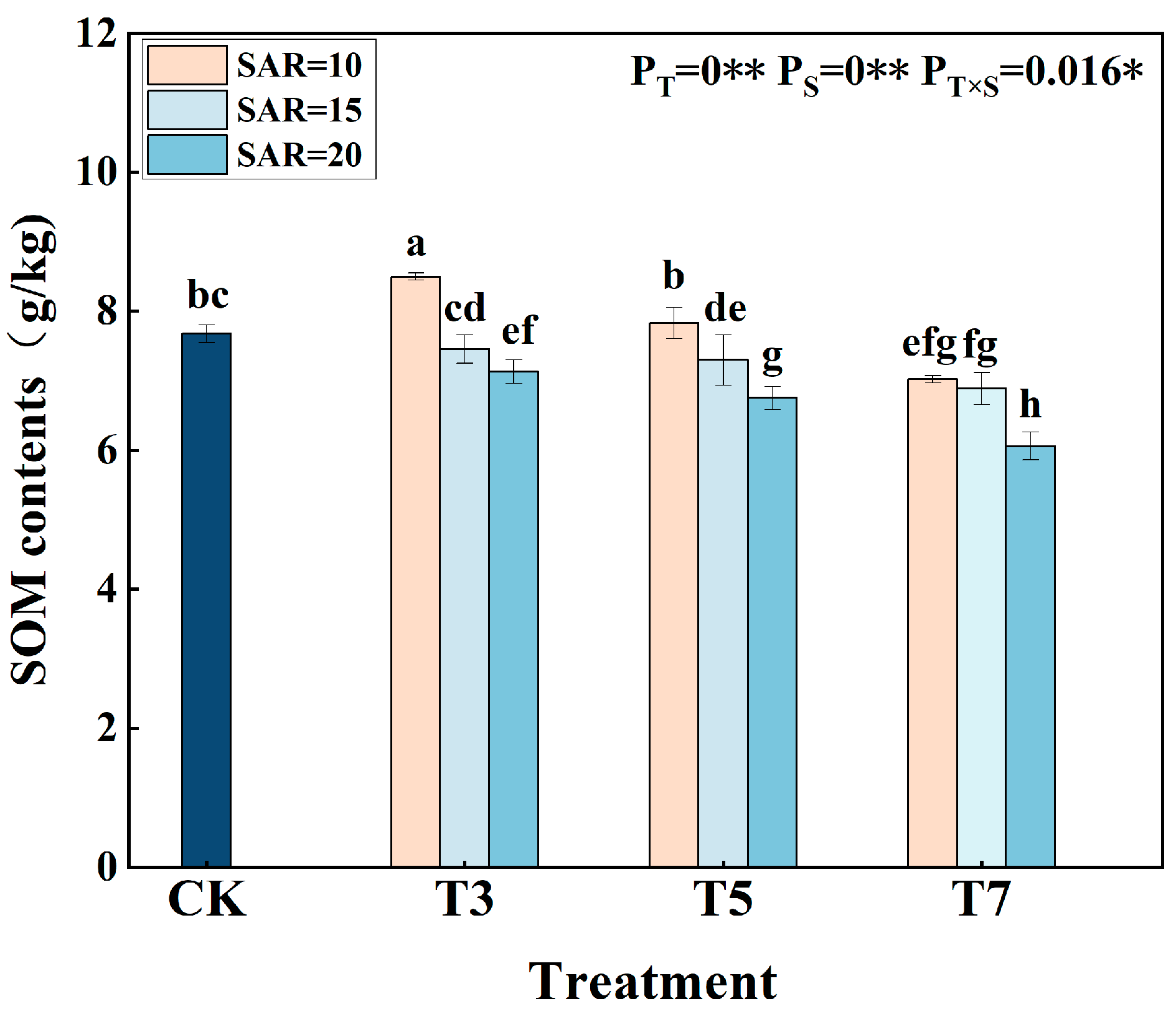
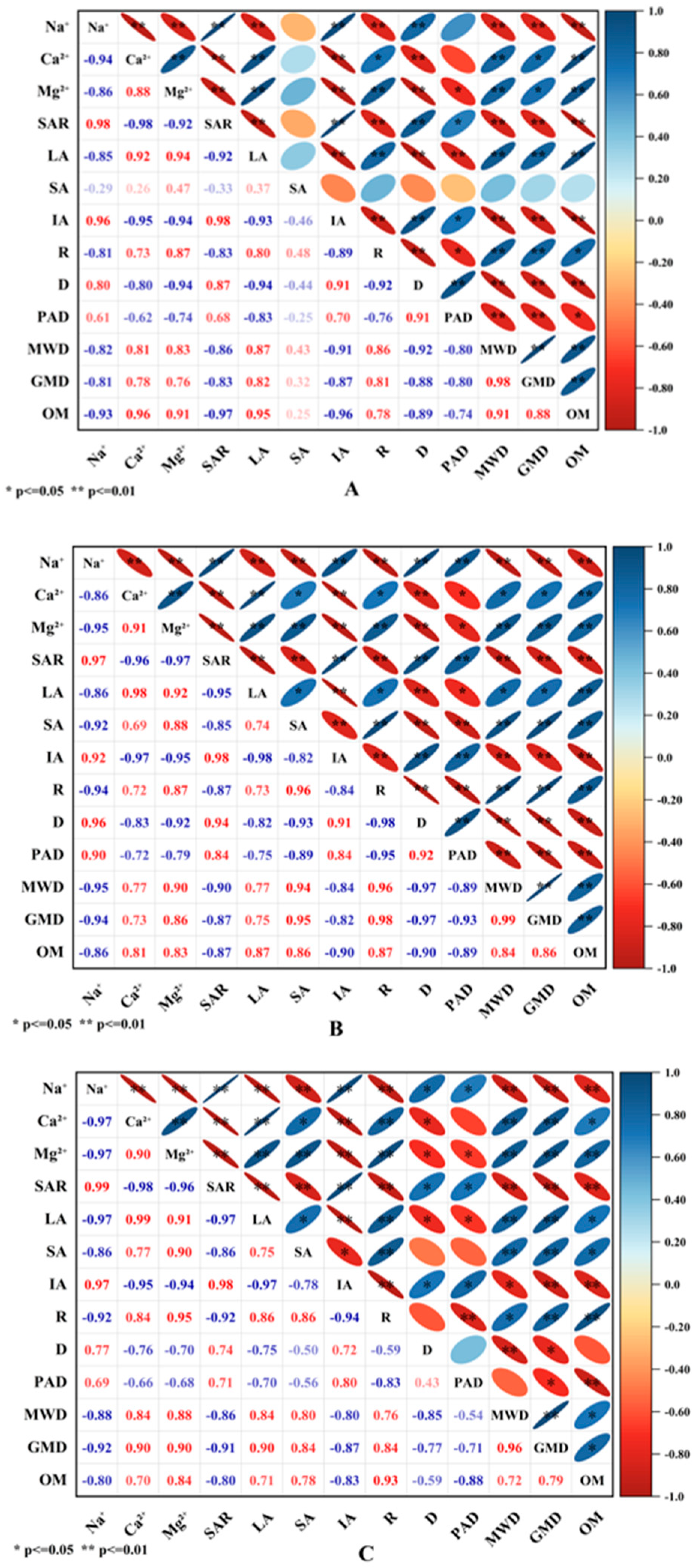
| Soil Depth (cm) | Na+ (g/kg) | Ca2+ (g/kg) | Mg2+ (g/kg) | SAR | Dry Bulk Density (g/cm3) | Field Capacity (cm3/cm−3) | Organic Matter (g/kg) | Soil Type |
|---|---|---|---|---|---|---|---|---|
| 0–20 | 0.09 | 0.11 | 0.03 | 0.87 | 1.6 | 0.26 | 5.66 | Sandy loam |
| Treatments | SAR (mmol/L)1/2 | Salinity (g/L) | Major Ion Content (mg/L) | |||||
|---|---|---|---|---|---|---|---|---|
| Ca2+ | Mg2+ | Na+ | K+ | Cl− | SO42− | |||
| CK | 8.74 | 1.44 | 103.60 | 42.07 | 419.09 | 6.45 | 648.10 | 87.54 |
| T3S10 | 10.10 | 3.00 | 356.69 | 42.07 | 759.08 | 6.45 | 1616.02 | 87.54 |
| T3S15 | 15.10 | 3.00 | 209.40 | 42.07 | 918.27 | 6.45 | 1604.10 | 87.54 |
| T3S20 | 20.11 | 3.00 | 121.78 | 42.07 | 1013.00 | 6.45 | 1597.01 | 87.54 |
| T5S10 | 10.11 | 5.00 | 789.42 | 42.07 | 1077.46 | 6.45 | 2864.91 | 87.54 |
| T5S15 | 15.08 | 5.00 | 536.00 | 42.07 | 1350.00 | 6.45 | 2844.47 | 87.54 |
| T5S20 | 20.11 | 5.00 | 368.69 | 42.07 | 1532.23 | 6.45 | 2830.87 | 87.54 |
| T7S10 | 10.10 | 7.00 | 1269.42 | 42.07 | 1344.74 | 6.45 | 4117.63 | 87.54 |
| T7S15 | 15.14 | 7.00 | 914.87 | 42.07 | 1727.97 | 6.45 | 4088.95 | 87.54 |
| T7S20 | 20.11 | 7.00 | 671.24 | 42.07 | 1991.32 | 6.45 | 4069.24 | 87.54 |
| Irrigation and fertilizer rates | 6.15 | 6.22 | 6.29 | 7.6 | 7.13 | 7.20 | 7.27 | 8.3 | 8.10 | 8.17 | 8.24 | Sum |
| Days to sow | 43 | 50 | 57 | 64 | 71 | 78 | 85 | 92 | 99 | 106 | 113 | 120 |
| Irrigation quota/mm | 37.5 | 36.48 | 34.89 | 38.49 | 41.22 | 43.95 | 38.27 | 42.45 | 43.14 | 37.37 | 26.36 | 420.12 |
| N/kg·hm−2 | 20.7 | 13.8 | 20.7 | 34.5 | 27.6 | 27.6 | 20.7 | 13.8 | 13.8 | 13.8 | 0 | 207.00 |
| P2O5/kg·hm−2 | 0 | 9 | 13.5 | 22.5 | 18 | 13.5 | 9 | 9 | 9 | 9 | 0 | 112.50 |
| K2O/kg·hm−2 | 0 | 4.8 | 9.6 | 9.6 | 9.6 | 24 | 24 | 19.2 | 14.4 | 4.8 | 0 | 120.00 |
| Treatments | D | PAD | MWD | GMD |
|---|---|---|---|---|
| CK | 2.969 d | 0.882 c | 0.370 a | 0.287 a |
| T3S10 | 2.969 d | 0.881 c | 0.362 a | 0.285 a |
| T3S15 | 2.972 c | 0.884 bc | 0.343 b | 0.281 b |
| T3S20 | 2.976 b | 0.890 b | 0.329 d | 0.278 b |
| T5S10 | 2.972 c | 0.884 bc | 0.341 bc | 0.280 b |
| T5S15 | 2.975 b | 0.886 bc | 0.333 cd | 0.278 b |
| T5S20 | 2.981 a | 0.901 a | 0.304 f | 0.268 d |
| T7S10 | 2.977 b | 0.887 bc | 0.316 e | 0.272 c |
| T7S15 | 2.982 a | 0.891 b | 0.301 f | 0.267 de |
| T7S20 | 2.982 a | 0.903 a | 0.296 f | 0.265 e |
| T | ** | ** | ** | ** |
| S | ** | ** | ** | ** |
| T × S | * | ns | ns | * |
Disclaimer/Publisher’s Note: The statements, opinions and data contained in all publications are solely those of the individual author(s) and contributor(s) and not of MDPI and/or the editor(s). MDPI and/or the editor(s) disclaim responsibility for any injury to people or property resulting from any ideas, methods, instructions or products referred to in the content. |
© 2024 by the authors. Licensee MDPI, Basel, Switzerland. This article is an open access article distributed under the terms and conditions of the Creative Commons Attribution (CC BY) license (https://creativecommons.org/licenses/by/4.0/).
Share and Cite
Xie, Y.; Ning, H.; Zhang, X.; Zhou, W.; Xu, P.; Song, Y.; Li, N.; Wang, X.; Liu, H. Reducing the Sodium Adsorption Ratio Improves the Soil Aggregates and Organic Matter in Brackish-Water-Irrigated Cotton Fields. Agronomy 2024, 14, 2169. https://doi.org/10.3390/agronomy14092169
Xie Y, Ning H, Zhang X, Zhou W, Xu P, Song Y, Li N, Wang X, Liu H. Reducing the Sodium Adsorption Ratio Improves the Soil Aggregates and Organic Matter in Brackish-Water-Irrigated Cotton Fields. Agronomy. 2024; 14(9):2169. https://doi.org/10.3390/agronomy14092169
Chicago/Turabian StyleXie, Yucai, Huifeng Ning, Xianbo Zhang, Wang Zhou, Peiwen Xu, Yinping Song, Nanfang Li, Xingpeng Wang, and Hao Liu. 2024. "Reducing the Sodium Adsorption Ratio Improves the Soil Aggregates and Organic Matter in Brackish-Water-Irrigated Cotton Fields" Agronomy 14, no. 9: 2169. https://doi.org/10.3390/agronomy14092169
APA StyleXie, Y., Ning, H., Zhang, X., Zhou, W., Xu, P., Song, Y., Li, N., Wang, X., & Liu, H. (2024). Reducing the Sodium Adsorption Ratio Improves the Soil Aggregates and Organic Matter in Brackish-Water-Irrigated Cotton Fields. Agronomy, 14(9), 2169. https://doi.org/10.3390/agronomy14092169









